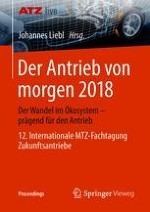2018 | OriginalPaper | Buchkapitel
Development methods for RDE-compliant powertrains
verfasst von : Tobias Mink, Christian Lensch-Franzen, Martin Schäfer, Alexander Ebel
Erschienen in: Der Antrieb von morgen 2018
Verlag: Springer Fachmedien Wiesbaden
Aktivieren Sie unsere intelligente Suche, um passende Fachinhalte oder Patente zu finden.
Wählen Sie Textabschnitte aus um mit Künstlicher Intelligenz passenden Patente zu finden. powered by
Markieren Sie Textabschnitte, um KI-gestützt weitere passende Inhalte zu finden. powered by
The ongoing change in mobility philosophy and the increased awareness regarding emission influence create new challenges for the powertrain development with focus on efficiency enhancement and emission reduction, especially under real driving conditions. As a result, the emission behaviour shows a high significance in addition to drivability, taking into account the overall lifetime and the increasing spread of load and gradient. At the same time, development cycles are becoming shorter and development costs are rising due to higher complexity and number of derivatives. This requires a systematic and efficient approach early in the powertrain development phase. To achieve the ecological and economic development objectives within shorter product cycles, the diversity of different influencing factors must be considered, analysed and, if necessary weighted according to their importance. This requires the use of a suitable development methodology, including target-oriented simulation tools, dynamic measurement techniques and a profound understanding of physical phenomena and mechanisms.In order to combine the increasingly complex interactions and the upcoming development targets, APL has developed a method chain based on a real driving data base (APL TrackKit) with different powertrain setups. The collected data is classified in terms of combustion process, specific power, transmission spread and vehicle-specific driving resistances. Based on a Design of Experiments (DoE) approach, a target configuration for the future powertrain setup is derived, considering the main influencing factors such as vehicle, driver, route and environmental parameters are identified. A systematic parameter variation of hardware, operating strategy and calibration is performed on the test bench, using a hardware-in-the-loop configuration with a real time simulation environment. The main optimization targets are energy efficiency, limited emissions and driving behaviour.The combination of state-of-the-art engine test benches, a simulated vehicle environment and online-tools as well as approval-relevant exhaust gas measurement technology of the RDE legislation enables optimal calibration and specific selection of hardware components in relation to the RDE-development both in the early development phase and during development.
